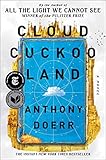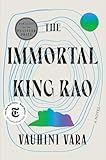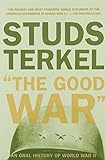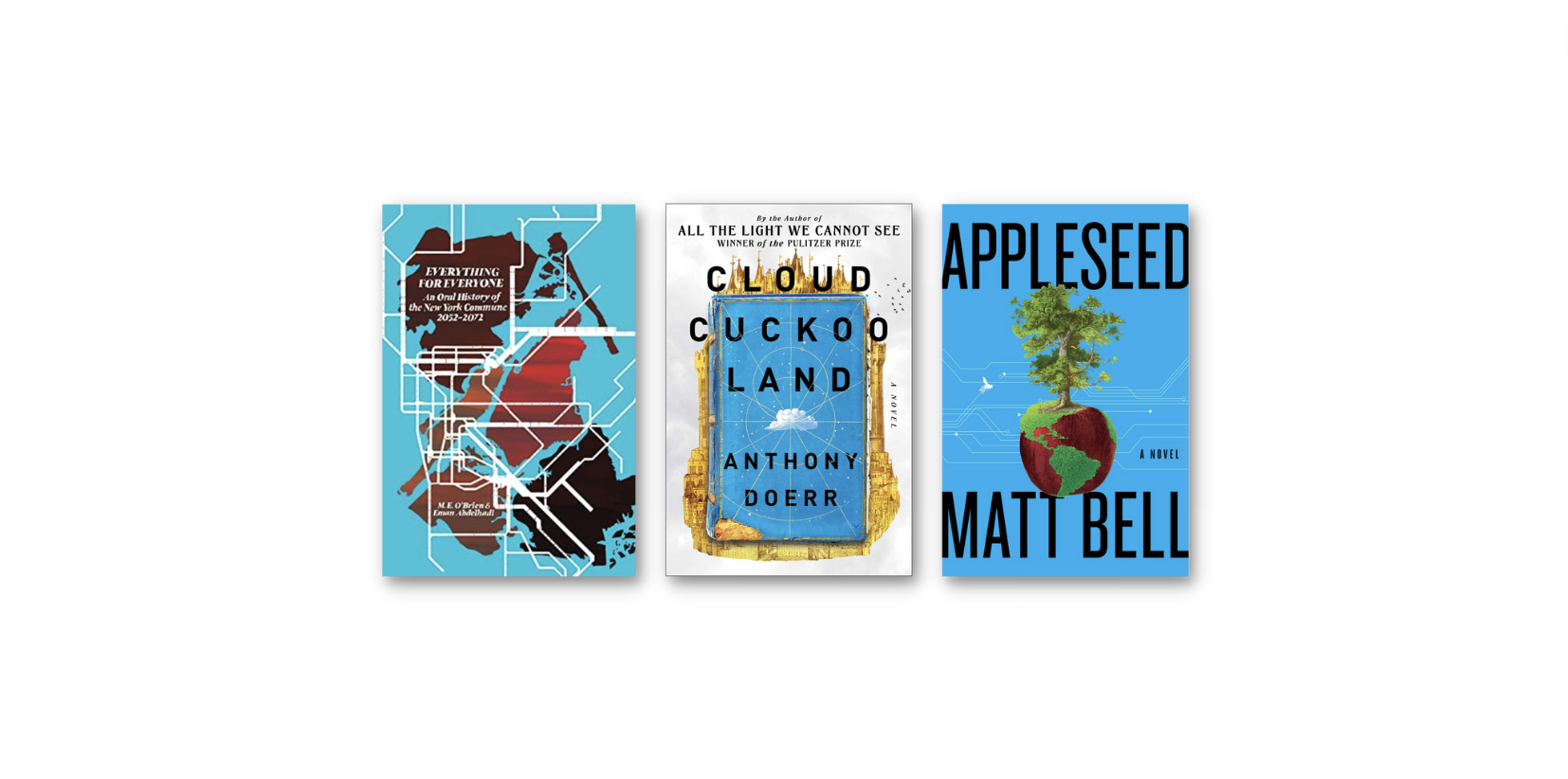Lenin’s prose tended toward the turgid more than the playfully gnomic, but when it comes to the aphorism that “there are decades where nothing happens; and there are weeks where decades happen,” it must be admitted that he wrote an absolute banger. Chiasmus has a way of making anything sound more profound. However, the past few years goes a long way to substantiating Lenin’s claim. The pandemic, supply chain shortages, the war, the insurrection—four of the horsemen right there, and that’s just since 2020. Just preamble to saying that reading books while the world is ending feels weird. If it’s true that literature acts as a mirror to reality, then certainly in my own reading I’ve been drawn to the post-apocalyptic as of late (like so many of you). There used to be a sense in which works envisioning the end of the world were cautionary, but now they read like survival manuals. Novels of collapse weren’t the only things I read in the last year, but as a syllabus of my own preoccupations, the opening of the seals and the blast of the trumpets has been on my mind. I’ve found communion in many of novels; a sense of not being the only anxious person, and sometimes the occasional glimpse of hope.




 There have been several door-stoppers written in the past decade that do for long history what the systems novels of the ’90s and 2000s did for social structures. Call these works “Epoch Novels” for the way that they range across centuries and often ingeniously structured. Reminiscent of David Mitchell’s Cloud Atlas, which inaugurated the form, and Epoch Novels are suited to the Anthropocene, when decades happen in weeks and the redness is setting in the West. This past year saw exemplary contributions like Matt Bell’s Appleseed, Monica Byrne’s The Actual Star, and Hanya Yanagihara’s To Paradise. An immediate classic is Anthony Doerr’s gorgeous Cloud Cuckoo Land, a fierce and moving defense of inventing stories. Structured like a series of concentric circles composed out of mirrors, and Cloud Cuckoo Land ranges from the Siege of Constantinople in 1453, mid-century Korea and England, current Idaho, to a starship in the near future. At the center of Doer’s novel is a fictitious ancient Greek play which shares his book’s title, and the many ways it’s been lost, rediscovered, and transformed over the millennia, fully aware of the blessed axiom that “when a book goes out of the world, the memory dies a second death.”
There have been several door-stoppers written in the past decade that do for long history what the systems novels of the ’90s and 2000s did for social structures. Call these works “Epoch Novels” for the way that they range across centuries and often ingeniously structured. Reminiscent of David Mitchell’s Cloud Atlas, which inaugurated the form, and Epoch Novels are suited to the Anthropocene, when decades happen in weeks and the redness is setting in the West. This past year saw exemplary contributions like Matt Bell’s Appleseed, Monica Byrne’s The Actual Star, and Hanya Yanagihara’s To Paradise. An immediate classic is Anthony Doerr’s gorgeous Cloud Cuckoo Land, a fierce and moving defense of inventing stories. Structured like a series of concentric circles composed out of mirrors, and Cloud Cuckoo Land ranges from the Siege of Constantinople in 1453, mid-century Korea and England, current Idaho, to a starship in the near future. At the center of Doer’s novel is a fictitious ancient Greek play which shares his book’s title, and the many ways it’s been lost, rediscovered, and transformed over the millennia, fully aware of the blessed axiom that “when a book goes out of the world, the memory dies a second death.”



 Narrative was also a central theme in Sequoia Nagamatsu’s evocative How High We Go in the Dark. An interconnected series of short stories which takes place a few decades from today and into the twenty-second century, and How High We Go in the Dark conveys the power which hard science fiction still holds over the imagination. Beginning on the eve of a pandemic unleashed from a virus preserved in a Neanderthal revealed by the melting Siberian permafrost, and Nagamatsu’s stories contain scenes of rending poignancy. An amusement park which functions as a euthanasia camp for infected children; a pig who develops consciousness as a result of scientists trying to find a cure; the first generation to embark on interstellar travel. “Hope, love, ingenuity. Possibility is more than what runs through our veins,” writes Nagamatsu, an author whose talent for soul-slaying makes him a successor to Annie Proulx or Alice Munro, if they had happened to write about talking pigs. The Millions’ own Emily St. John Mandel returned to post-apocalypse in The Sea of Tranquility, which much like Doerr’s novel was about how crafting stories generates meaning. Author of the best post-apocalyptic novel of this century in Station Eleven, Mandel’s latest book returns to the subject of pandemic. Both an Epoch Novel and a time travel tale in the tradition of Ray Bradbury’s “A Sound of Thunder” and Kurt Vonnegut’s Slaughterhouse-Five, and Sea of Tranquility ranges from the Belle epoque Pacific Northwest, to our present, and a human colony on the moon centuries into the future. Among the most engaging storylines concerns a Lunar author on a book tour as plague breaks out, a scenario evoking Mandel having to discuss Station Eleven as Covid spread. “That’s the strange lesson of living life in a pandemic,” writes Mandel, “life can be tranquil in the face of death.”
Narrative was also a central theme in Sequoia Nagamatsu’s evocative How High We Go in the Dark. An interconnected series of short stories which takes place a few decades from today and into the twenty-second century, and How High We Go in the Dark conveys the power which hard science fiction still holds over the imagination. Beginning on the eve of a pandemic unleashed from a virus preserved in a Neanderthal revealed by the melting Siberian permafrost, and Nagamatsu’s stories contain scenes of rending poignancy. An amusement park which functions as a euthanasia camp for infected children; a pig who develops consciousness as a result of scientists trying to find a cure; the first generation to embark on interstellar travel. “Hope, love, ingenuity. Possibility is more than what runs through our veins,” writes Nagamatsu, an author whose talent for soul-slaying makes him a successor to Annie Proulx or Alice Munro, if they had happened to write about talking pigs. The Millions’ own Emily St. John Mandel returned to post-apocalypse in The Sea of Tranquility, which much like Doerr’s novel was about how crafting stories generates meaning. Author of the best post-apocalyptic novel of this century in Station Eleven, Mandel’s latest book returns to the subject of pandemic. Both an Epoch Novel and a time travel tale in the tradition of Ray Bradbury’s “A Sound of Thunder” and Kurt Vonnegut’s Slaughterhouse-Five, and Sea of Tranquility ranges from the Belle epoque Pacific Northwest, to our present, and a human colony on the moon centuries into the future. Among the most engaging storylines concerns a Lunar author on a book tour as plague breaks out, a scenario evoking Mandel having to discuss Station Eleven as Covid spread. “That’s the strange lesson of living life in a pandemic,” writes Mandel, “life can be tranquil in the face of death.”

 Technology was a focus of several of the novels which I read, examining how social media can rewire our consciousness or how surveillance capitalism turns your friends and neighbors into digital voyeurs and your big brother into Big Brother. Vauhini Vara’s The Immortal King Rao is about an Indian immigrant who becomes a billionaire in this alternative history of the tech industry, while examining how personal computers and smart phones have altered human experience. Both utopian and dystopian, immigrant success novel, manifesto for revolution, and the story of how children and parents can simultaneously love and yet not understand one another. Enmeshed in the difficulties of human connection even in (especially in) the Cloud, and Vara’s is the audacious tale of King Rao who “left this world the most influential person ever to have lived” but who “entered it possessing not even a name.” Technology’s perils and promises are plumbed in Rebecca Scherm’s epic A House Between the Earth and the Moon which toggles between the Parallaxis space station and an Earth ravaged by wildfires and overrun with desperate climate refugees. On Parallaxis, Alex Welch-Peters and his colleagues believe they’re conducting research to ameliorate climate change, when they’re actually preparing a luxury ark for billionaires. Still, A House Between the Earth and the Moon provides space for hope and for tenderness, of a mutual acknowledgement of our Earth, “huge and round and real” where white “Streaks wrapped the blue and green marble like cotton, protecting it.”
Technology was a focus of several of the novels which I read, examining how social media can rewire our consciousness or how surveillance capitalism turns your friends and neighbors into digital voyeurs and your big brother into Big Brother. Vauhini Vara’s The Immortal King Rao is about an Indian immigrant who becomes a billionaire in this alternative history of the tech industry, while examining how personal computers and smart phones have altered human experience. Both utopian and dystopian, immigrant success novel, manifesto for revolution, and the story of how children and parents can simultaneously love and yet not understand one another. Enmeshed in the difficulties of human connection even in (especially in) the Cloud, and Vara’s is the audacious tale of King Rao who “left this world the most influential person ever to have lived” but who “entered it possessing not even a name.” Technology’s perils and promises are plumbed in Rebecca Scherm’s epic A House Between the Earth and the Moon which toggles between the Parallaxis space station and an Earth ravaged by wildfires and overrun with desperate climate refugees. On Parallaxis, Alex Welch-Peters and his colleagues believe they’re conducting research to ameliorate climate change, when they’re actually preparing a luxury ark for billionaires. Still, A House Between the Earth and the Moon provides space for hope and for tenderness, of a mutual acknowledgement of our Earth, “huge and round and real” where white “Streaks wrapped the blue and green marble like cotton, protecting it.”

 Technocratic dystopia is one future possibility, while complete collapse is another. Our Cassandras oft-investigate the latter, post-apocalyptic America in symmetry with the frontier violence that inaugurated our nation. Ken Kalfus’s ingenious 2 A.M. in Little America provides a dream-like recounting of the human toll of a future civil war. Reminiscent of Franz Kafka and Albert Camus, 2 A.M. in Little America’s stripped-down prose and ambiguity is a modernist novella of ideas. The conceit of Kalfus’s book is that the United States has balkanized, and the nation’s refugees are unwelcome immigrants in foreign cities, separated into enclaves where they recreate strip malls and big box stores. His protagonist Ron Patterson lives in exile, shunted from capital to foreign capital, unwelcome everywhere. Kalfus doesn’t tell us what countries his Wandering American is living in (maybe the Mediterranean or Caribbean, South America or Asia), and crucially we don’t know which “side” he was on. “Americans kept away from each other then,” writes Kalfus, the schisms of the culture wars reduced to mere tribalism, leaving “only… our grief and our shame.” Jocelyn Nicole Johnson’s novella My Monticello also foretells future civil war. “We claimed it first, this little mountain,” says Da’Naisha, the narrator of My Monticello, a Black resident of Charlottesville, a University of Virginia student, and a direct ancestor of the third president. After marauding gangs of white supremacists attack her neighborhood, she escapes to Thomas Jefferson’s plantation. A survivor’s tale written in our dark age of tiki torches and “Unite the Right,” the Proud Boys and Patriot Front. In contrast to the ugliness of their adversaries, Da’Naisha and her compatriots discover mutual solidarity while facing a hideous threat, as My Monticello strips bare the myths of America to show the nation as it has always been, while gesturing towards a promise of what it yet could be.
Technocratic dystopia is one future possibility, while complete collapse is another. Our Cassandras oft-investigate the latter, post-apocalyptic America in symmetry with the frontier violence that inaugurated our nation. Ken Kalfus’s ingenious 2 A.M. in Little America provides a dream-like recounting of the human toll of a future civil war. Reminiscent of Franz Kafka and Albert Camus, 2 A.M. in Little America’s stripped-down prose and ambiguity is a modernist novella of ideas. The conceit of Kalfus’s book is that the United States has balkanized, and the nation’s refugees are unwelcome immigrants in foreign cities, separated into enclaves where they recreate strip malls and big box stores. His protagonist Ron Patterson lives in exile, shunted from capital to foreign capital, unwelcome everywhere. Kalfus doesn’t tell us what countries his Wandering American is living in (maybe the Mediterranean or Caribbean, South America or Asia), and crucially we don’t know which “side” he was on. “Americans kept away from each other then,” writes Kalfus, the schisms of the culture wars reduced to mere tribalism, leaving “only… our grief and our shame.” Jocelyn Nicole Johnson’s novella My Monticello also foretells future civil war. “We claimed it first, this little mountain,” says Da’Naisha, the narrator of My Monticello, a Black resident of Charlottesville, a University of Virginia student, and a direct ancestor of the third president. After marauding gangs of white supremacists attack her neighborhood, she escapes to Thomas Jefferson’s plantation. A survivor’s tale written in our dark age of tiki torches and “Unite the Right,” the Proud Boys and Patriot Front. In contrast to the ugliness of their adversaries, Da’Naisha and her compatriots discover mutual solidarity while facing a hideous threat, as My Monticello strips bare the myths of America to show the nation as it has always been, while gesturing towards a promise of what it yet could be.


 Some works showed not just the apocalypse, but the genesis afterwards. Kim Stanley Robinson has long been such a utopian. The Ministry for the Future contains a terrifying, opening depiction of a “wet bulb” event in India which scorches millions of people to death in a few days, but out of such horror Robinson supplies exacting consideration of how climate change could stalled, economic inequity reduced, human misery eliminated. An author who favors the concrete over the abstract, and The Ministry of the Future reads not like a parable but a position paper, which is to its benefit. Robinson’s central character Mary Murphy, director of the United Nations’ Ministry for the Future, is the character through which this information is focalized; considerations of ice cores in Antarctica and helium balloons in the Alps, providing not a road map but at least a possibility of how apocalypse could be averted. “We will keep going, we will keep going,” writes Robinson, “Because we never really come to the end.” More audacious, more radical, and even more utopian than Robinson, is Everything for Everyone: An Oral History of the New York Commune, 2052-2072 by M.E. O’Brien and Eman Abdelhadi. Composed as a series of interviews reminiscent of Studs Terkel’s The Good War, and future versions of both O’Brien and Abdelhadi talk with various characters ranging from sex workers to historians about how global capitalism was abolished by communitarian revolutionaries. From the ashes of our world then comes a fairer, more just, and more free society, where this brave new world “preserved and transformed authentically loving features of the old society, but in radical and often unrecognizable new forms.”
Some works showed not just the apocalypse, but the genesis afterwards. Kim Stanley Robinson has long been such a utopian. The Ministry for the Future contains a terrifying, opening depiction of a “wet bulb” event in India which scorches millions of people to death in a few days, but out of such horror Robinson supplies exacting consideration of how climate change could stalled, economic inequity reduced, human misery eliminated. An author who favors the concrete over the abstract, and The Ministry of the Future reads not like a parable but a position paper, which is to its benefit. Robinson’s central character Mary Murphy, director of the United Nations’ Ministry for the Future, is the character through which this information is focalized; considerations of ice cores in Antarctica and helium balloons in the Alps, providing not a road map but at least a possibility of how apocalypse could be averted. “We will keep going, we will keep going,” writes Robinson, “Because we never really come to the end.” More audacious, more radical, and even more utopian than Robinson, is Everything for Everyone: An Oral History of the New York Commune, 2052-2072 by M.E. O’Brien and Eman Abdelhadi. Composed as a series of interviews reminiscent of Studs Terkel’s The Good War, and future versions of both O’Brien and Abdelhadi talk with various characters ranging from sex workers to historians about how global capitalism was abolished by communitarian revolutionaries. From the ashes of our world then comes a fairer, more just, and more free society, where this brave new world “preserved and transformed authentically loving features of the old society, but in radical and often unrecognizable new forms.”

 Two novels which I read in 2022 aren’t about the apocalypse per se, though both feature the end of a world, and the glimmers of different one to come. Sarah Thankam Matthews’s All This Could be Different is the great novel of the millennial generation concerned as it is with Sneha who works a dead-end office internship in the prototypical Rust Belt metropolis of Milwaukee in the waning days of the Great Recession. All This Could Be Different is a work of uncommon empathy, with finely textured characters in Sneha’s circle of friends, from the various women that she dates to her college friends, but most remarkable are the ways in which Matthews captures a particular structure of feeling which dominates those who came of age after 9/11 and before the 2008 market collapse. Everyone lives paycheck to paycheck in poorly constructed but elegant apartments in gentrifying neighborhoods where they’re charged exorbitant rent; they’re buried under student loan debt and work in absurdly bullshit jobs, while spending their evenings discussing radical politics but seemingly doing nothing. “The world we knew has always been half-terrible, made as it is by the powerful, for the powerful,” writes Matthews, yet “We were crowning a different one. Its birth would not be easy; no birth was.” There are no schematics or blueprints, no proposed legislation or white papers in All This Could Be Different, yet there is hope. Lauren Groff’s Matrix, by contrast, is set in Medieval England, but it also depicts the fading of one world and the possibility of an alternative way of being—a communal, egalitarian, free manner of living. Written by one of our most singularly talented authors, and Matrix’s main character is the twelfth-century nun, poet, and mystic Marie de France as she constructs an entirely different society within her convent. “Those to whom God has given understanding and eloquence must not be silent or hide their gift,” muses Marie, “but must return the gift so that it flowers.” In our own humid and hazy apocalypse, Matrix is such a gift. Though it is not a long book, it took me a ponderously long time to finish, simply because Groff’s prose is so shimmering it demands that each word be weighed. Matrix is the rare novel as perfect as a sonnet. If there is any answer to disintegration and entropy, to the great unravelling we face, it’s in the awareness that there are talents such as these, that can do such things with words. That can make it seem that the world could be created again.
Two novels which I read in 2022 aren’t about the apocalypse per se, though both feature the end of a world, and the glimmers of different one to come. Sarah Thankam Matthews’s All This Could be Different is the great novel of the millennial generation concerned as it is with Sneha who works a dead-end office internship in the prototypical Rust Belt metropolis of Milwaukee in the waning days of the Great Recession. All This Could Be Different is a work of uncommon empathy, with finely textured characters in Sneha’s circle of friends, from the various women that she dates to her college friends, but most remarkable are the ways in which Matthews captures a particular structure of feeling which dominates those who came of age after 9/11 and before the 2008 market collapse. Everyone lives paycheck to paycheck in poorly constructed but elegant apartments in gentrifying neighborhoods where they’re charged exorbitant rent; they’re buried under student loan debt and work in absurdly bullshit jobs, while spending their evenings discussing radical politics but seemingly doing nothing. “The world we knew has always been half-terrible, made as it is by the powerful, for the powerful,” writes Matthews, yet “We were crowning a different one. Its birth would not be easy; no birth was.” There are no schematics or blueprints, no proposed legislation or white papers in All This Could Be Different, yet there is hope. Lauren Groff’s Matrix, by contrast, is set in Medieval England, but it also depicts the fading of one world and the possibility of an alternative way of being—a communal, egalitarian, free manner of living. Written by one of our most singularly talented authors, and Matrix’s main character is the twelfth-century nun, poet, and mystic Marie de France as she constructs an entirely different society within her convent. “Those to whom God has given understanding and eloquence must not be silent or hide their gift,” muses Marie, “but must return the gift so that it flowers.” In our own humid and hazy apocalypse, Matrix is such a gift. Though it is not a long book, it took me a ponderously long time to finish, simply because Groff’s prose is so shimmering it demands that each word be weighed. Matrix is the rare novel as perfect as a sonnet. If there is any answer to disintegration and entropy, to the great unravelling we face, it’s in the awareness that there are talents such as these, that can do such things with words. That can make it seem that the world could be created again.









